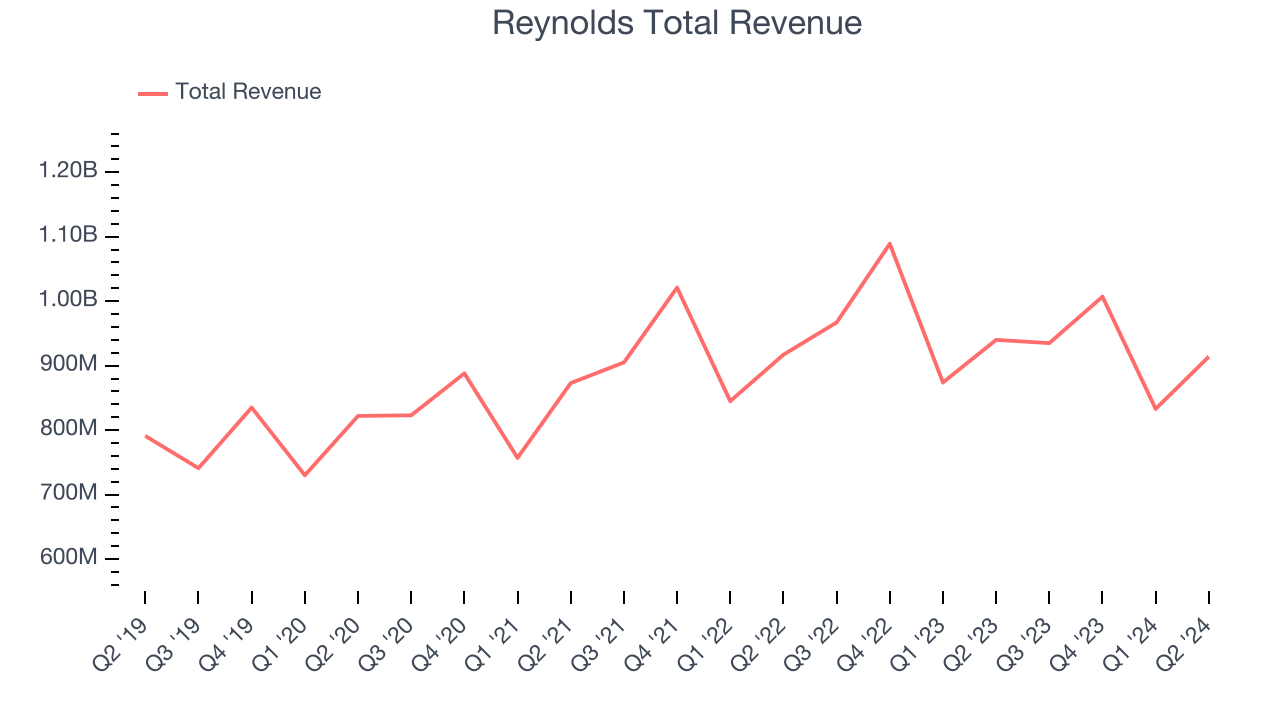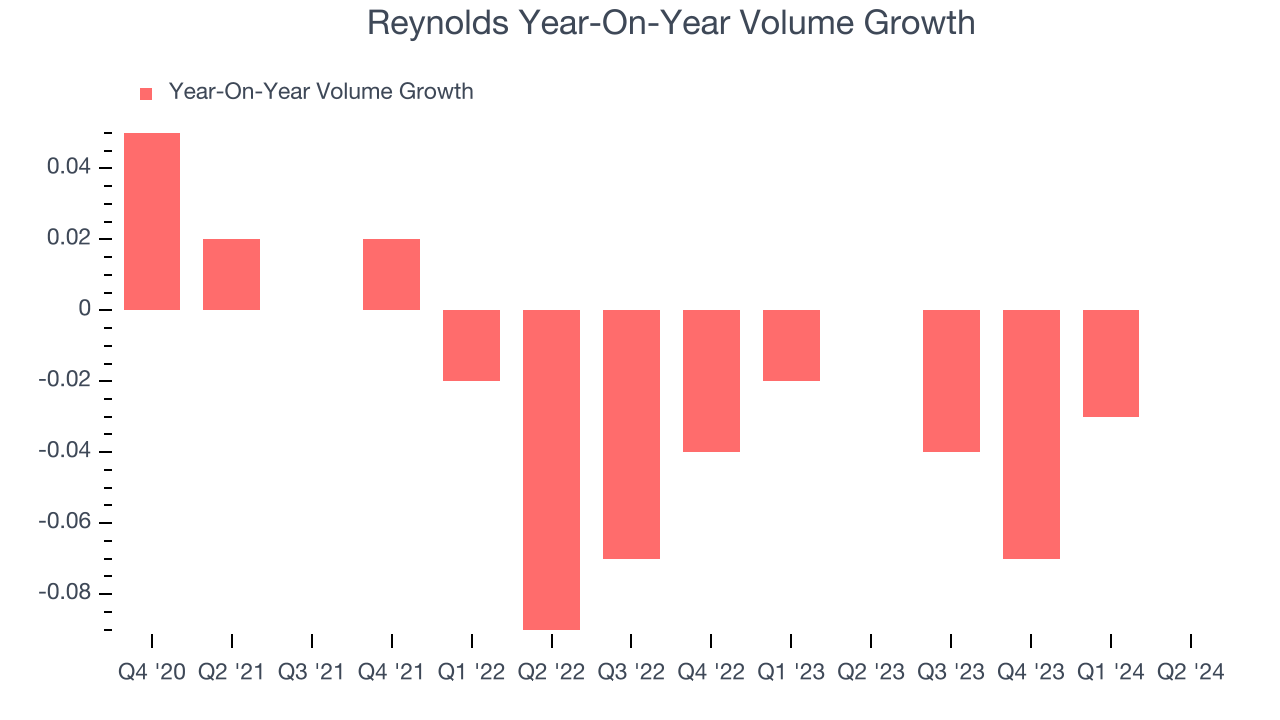Household products company Reynolds (NASDAQ:REYN) reported Q2 CY2024 results beating Wall Street analysts' expectations, with revenue down 2.8% year on year to $914 million. The company expects next quarter's revenue to be around $900 million, in line with analysts' estimates. It made a non-GAAP profit of $0.32 per share, improving from its profit of $0.32 per share in the same quarter last year.
Is now the time to buy Reynolds? Find out by accessing our full research report, it's free.
Reynolds (REYN) Q2 CY2024 Highlights:
- Revenue: $914 million vs analyst estimates of $892.7 million (2.4% beat)
- EPS (non-GAAP): $0.32 vs analyst expectations of $0.44 (26.9% miss)
- Revenue Guidance for Q3 CY2024 is $900 million at the midpoint, roughly in line with what analysts were expecting
- The company lifted its revenue guidance for the full year from $3.59 billion to $3.63 billion at the midpoint, a 1.3% increase
- EPS (non-GAAP) guidance for Q3 CY2024 is $0.41 at the midpoint, above analyst estimates of $0.40
- EPS (non-GAAP) guidance for the full year is $1.68 at the midpoint, roughly in line with what analysts were expecting
- Gross Margin (GAAP): 174%, up from 24.3% in the same quarter last year
- EBITDA Margin: 18.8%, up from 16% in the same quarter last year
- Free Cash Flow of $65 million, similar to the previous quarter
- Organic Revenue fell 1% year on year (3% in the same quarter last year)
- Sales Volumes were flat year on year, in line with the same quarter last year
- Market Capitalization: $6.00 billion
“Strong retail revenue performance in each of our business units resulted in RCP outperforming our categories during the quarter,” said Lance Mitchell, CEO and President of Reynolds Consumer Products.
Best known for its aluminum foil, Reynolds (NASDAQ:REYN) is a household products company whose products focus on food storage, cooking, and waste.
Household Products
Household products stocks are generally stable investments, as many of the industry's products are essential for a comfortable and functional living space. Recently, there's been a growing emphasis on eco-friendly and sustainable offerings, reflecting the evolving consumer preferences for environmentally conscious options. These trends can be double-edged swords that benefit companies who innovate quickly to take advantage of them and hurt companies that don't invest enough to meet consumers where they want to be with regards to trends.
Sales Growth
Reynolds is larger than most consumer staples companies and benefits from economies of scale, giving it an edge over its smaller competitors.
As you can see below, the company's annualized revenue growth rate of 3.4% over the last three years was sluggish as consumers bought less of its products. We'll explore what this means in the "Volume Growth" section.

This quarter, Reynolds's revenue fell 2.8% year on year to $914 million but beat Wall Street's estimates by 2.4%. The company is guiding for a 3.7% year-on-year revenue decline next quarter to $900 million, a further deceleration from the 3.3% year-on-year decrease it recorded in the same quarter last year. Looking ahead, Wall Street expects revenue to decline 1.2% over the next 12 months.
Today’s young investors won’t have read the timeless lessons in Gorilla Game: Picking Winners In High Technology because it was written more than 20 years ago when Microsoft and Apple were first establishing their supremacy. But if we apply the same principles, then enterprise software stocks leveraging their own generative AI capabilities may well be the Gorillas of the future. So, in that spirit, we are excited to present our Special Free Report on a profitable, fast-growing enterprise software stock that is already riding the automation wave and looking to catch the generative AI next.
Volume Growth
Revenue growth can be broken down into changes in price and volume (the number of units sold). While both are important, volume is the lifeblood of a successful staples business as there’s a ceiling to what consumers will pay for everyday goods; they can always trade down to non-branded products if the branded versions are too expensive.
To analyze whether Reynolds generated its growth (or lack thereof) from changes in price or volume, we can compare its volume growth to its organic revenue growth, which excludes non-fundamental impacts on company financials like mergers and currency fluctuations.
Over the last two years, Reynolds's average quarterly sales volumes have shrunk by 3.4%. This isn't ideal for a consumer staples company, where demand is typically stable. Luckily, Reynolds was able to offset fewer customers purchasing its products by charging higher prices, enabling it to maintain its organic sales. We hope the company can grow its volumes soon, however, as consistent price increases (on top of inflation) aren't sustainable over the long term unless the business is really really special.

In Reynolds's Q2 2024, year on year sales volumes were flat. This result was more or less in line with the same quarter last year.
Key Takeaways from Reynolds's Q2 Results
We were impressed by how significantly Reynolds blew past analysts' gross margin expectations this quarter. We were also excited its organic revenue growth outperformed Wall Street's estimates. On the other hand, its EPS missed analysts' expectations. Overall, this quarter seemed fairly positive and shareholders should feel optimistic. The stock traded up 3.1% to $29.47 immediately after reporting.
Reynolds may have had a good quarter, but does that mean you should invest right now? When making that decision, it's important to consider its valuation, business qualities, as well as what has happened in the latest quarter. We cover that in our actionable full research report which you can read here, it's free.
